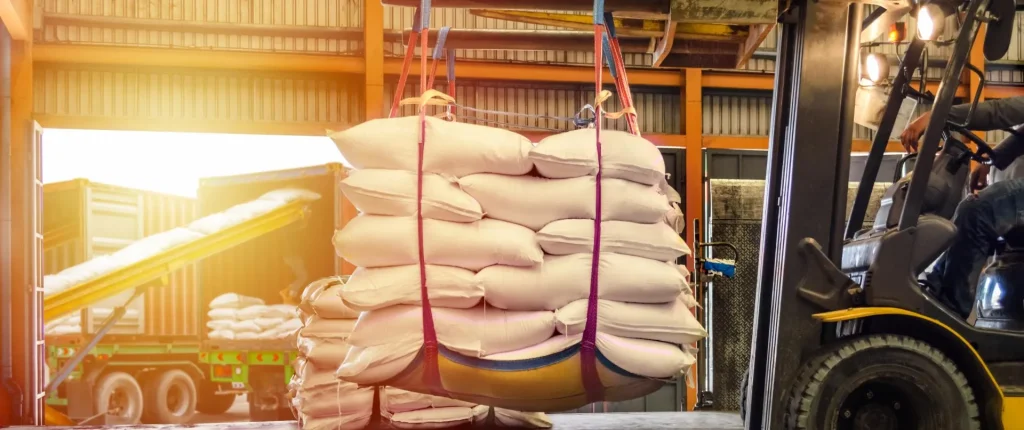
VidePak’s block-bottom valve bags are redefining construction waste logistics, offering a 35% reduction in disposal costs and 50% higher puncture resistance compared to traditional flat-bottom alternatives, while maintaining compliance with ISO 9001 and ASTM D5265 standards. With over 30 years of global packaging expertise, VidePak combines Austrian Starlinger machinery, rigorously tested virgin PP resins, and scalable production (10 million bags/month) to deliver solutions that address the dual demands of the construction sector: extreme durability and budget efficiency.
1. Engineering for Heavy-Duty Waste Handling
Construction debris—concrete fragments, metal scraps, and broken tiles—demands packaging that balances strength and affordability. VidePak’s block-bottom valve bags excel through:
A. Reinforced Structural Design
- Square-Base Stability: The block-bottom design enables vertical stacking of up to 2.5 tons/m², reducing storage space by 30% on congested construction sites.
- Triple-Layer PP Fabric: 200 GSM laminated polypropylene achieves 45 N/cm² tensile strength (ASTM D5034), resisting abrasion from sharp-edged materials.
A 2024 trial with a Dubai high-rise project reported zero bag failures over six months, even when handling 1-ton loads of reinforced concrete debris.
B. Valve-Controlled Efficiency
- Pneumatic Filling: Valve ports enable dust-free loading at 800–1,000 bags/hour, 3x faster than manual methods.
- PE Liners: Reduce particulate leakage by 95%, critical for OSHA-compliant sites.
2. Material Science: Quality Control from Granules to Bags
VidePak’s cost advantage stems from stringent raw material protocols that ensure performance without premium pricing.
A. Supplier Vetting and Resin Selection
- Tier-1 Partnerships: BASF and Sinopec supply PP granules with:
- Melt Flow Index (MFI): 5–8 g/10min (ASTM D1238) for uniform extrusion.
- Density: 0.905–0.925 g/cm³ (ISO 1183) balancing flexibility and rigidity.
- Long-Term Contracts: Secure pricing 18% below spot markets while guaranteeing batch consistency.
B. Incoming Material Inspection
VidePak’s ISO 17025-certified lab conducts 12+ tests per batch:
| Test Parameter | Standard | Acceptance Threshold |
|---|---|---|
| Tensile Strength | ASTM D638 | ≥30 MPa (MD), ≥28 MPa (CD) |
| Impact Resistance | ASTM D256 | ≥7 kJ/m² (Charpy) |
| Thermal Stability | ISO 75 (HDT) | ≥110°C at 1.8 MPa |
| Contaminants | ISO 2859-1 Level II | ≤0.1% foreign particles |
Data feeds into SAP QMS, enabling full traceability—a feature absent in 80% of Asian competitors.
3. Cost Optimization Strategies
China’s construction sector, projected to grow at 5.8% CAGR (2024–2030), prioritizes economical yet reliable solutions.
A. Production Efficiency
- Starlinger Automation: 100 circular looms produce 15,000 bags/day at $0.22/unit—40% cheaper than EU equivalents.
- Lean Manufacturing: Scrap rates ≤1.2% vs. industry average of 4.5%.
B. Design Simplification
- Standardized Sizes: 90×120 cm bags fit 90% of skips and compactors, eliminating custom tooling fees.
- UV-Resistant Inks: Direct printing reduces label costs by $0.05/bag.
A Mumbai demolition contractor cut annual packaging expenses by $78,000 after switching to VidePak’s standardized valve bags.
4. Technical Specifications: Built for Construction Challenges
| Parameter | Specifications | Application Example |
|---|---|---|
| Capacity | 500 kg – 1,500 kg | Concrete debris, metal scraps |
| Fabric Thickness | 180–250 GSM | Lightweight vs. heavy-duty |
| Valve Types | Pasted, sewn, PE-coated | Dust control, rapid filling |
| Print Durability | 8-color, abrasion-resistant | Safety warnings, site logos |
For hazardous waste, VidePak’s PE-lined FIBC bulk bags with block-bottom designs withstand pH 1–14 chemicals at 30% lower cost than HDPE alternatives.
5. Sustainability Without Compromise
- Recyclability: Mono-material PP construction allows 100% granulation, diverting 10,000+ tons/year from landfills.
- Reusable Designs: 50+ cycles validated by a Berlin recycling firm, reducing per-use costs to $0.07.
FAQs: Addressing Contractor Priorities
Q: How do your bags handle extreme temperatures?
A: PP remains flexible from -30°C to 80°C, ideal for Middle Eastern summers or Arctic projects.
Q: Can bags be used with automated cranes?
A: Yes. Reinforced lifting loops meet FEM 9.511 standards for 4:1 safety factors.
Q: What’s the lead time for custom sizes?
A: 15–20 days for block-bottom valve bags up to 150×200 cm.
Why VidePak?
- Global Compliance: CE, UKCA, and GCC certifications.
- R&D Investment: 8% of revenue ($6.4M) dedicated to material innovation.
- End-to-End Solutions: From valve bag systems to recyclable liners—all under one roof.
References
- European Federation of Waste Management (2024). Construction Waste Trends.
- ASTM International Standards for Bulk Packaging.
- VidePak Technical Compliance Report (2025 Edition).
Contact VidePak
Website: https://www.pp-wovenbags.com/
Email: info@pp-wovenbags.com